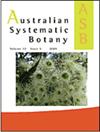Simonachne是从Ancisrachne s.l.(禾本科:圆锥总科:圆锥科)和Cleistochloinae新亚种中分离出来的一个澳大利亚新属
IF 1.6
3区 生物学
Q4 EVOLUTIONARY BIOLOGY
引用次数: 3
摘要
摘要描述了一个新属Simonachne E.J.Thomps,并将Ancisrachne maidenii(A.A.Ham.)Vickery转移到该属上,命名为Simonachne-maidenii(A.A.Ham,通过与生殖二态性相关的独特形态结合在一起。使用控制论分析来检查分类群的相似性,并测试结果与分析输入变化的一致性。输入变化包括样本组成和形态特征方面的数据集,以及聚类分析算法,即分类、排序和关联测度。基线数据集用于比较结果,包括24个样本和161个与小穗、叶片和可育秆的解剖、微观和宏观形态有关的特征。解决了三个主要的类群,Cleistochloinae(“cleistogamy group”)、Neurachninae(其原始意义上)和一个被称为“圆锥花序群”的类群,由Anistrachne s.s.、Entolasia和Panicum s.s.组成。结果与最近的系统发育研究一致,该研究表明Anistrachine s.l。,Cleistochloa s.l.和Dimorphochloa s.l.不是单系。这一过程提供了一系列形态特征,用于描述物种,并区分自然类群中多个等级的分类群,分别是阿尔法和贝塔分类学的组成部分。本文章由计算机程序翻译,如有差异,请以英文原文为准。
Simonachne, a new genus for Australia segregated from Ancistrachne s.l. (Poaceae : Panicoideae : Paniceae) and a new subtribe Cleistochloinae
ABSTRACT A new genus, Simonachne E.J.Thomps. is described and Ancistrachne maidenii (A.A.Ham.) Vickery is transferred to it as Simonachne maidenii (A.A.Ham.) E.J.Thomps. The new subtribe Cleistochloinae E.J.Thomps. is described and is composed of four genera, Calyptochloa, Cleistochloa, Dimorphochloa and Simonachne, united by distinctive morphology that is associated with reproductive dimorphism. Phenetic analyses were used to examine the similarities of taxa and to test the consistency of results with variation in analysis inputs. Input variations included the dataset in terms of composition of the samples and morphological characters, and the cluster analysis algorithms, viz. classification, ordination and association measure. A baseline dataset was used for comparison of results and comprised 24 samples and 161 characters relating to anatomy, micro- and macromorphology of spikelets, leaves and fertile culms. Three major clusters were resolved, Cleistochloinae (‘the cleistogamy group‚), Neurachninae in its original sense, and a cluster referred to as the ‘paniculate inflorescence group‚ composed of Ancistrachne s.s., Entolasia and Panicum s.s. The results were congruent with a recent phylogenetic study that showed that Ancistrachne s.l., Cleistochloa s.l. and Dimorphochloa s.l. were not monophyletic. The process provided an array of morphological characters for descriptions of species and for distinguishing taxa at multiple ranks in natural groups, components of alpha and beta taxonomy respectively.
求助全文
通过发布文献求助,成功后即可免费获取论文全文。
去求助
来源期刊

Australian Systematic Botany
生物-进化生物学
CiteScore
3.10
自引率
12.50%
发文量
12
审稿时长
>12 weeks
期刊介绍:
Australian Systematic Botany is an international journal devoted to the systematics, taxonomy, and related aspects of biogeography and evolution of all algae, fungi and plants, including fossils. Descriptive taxonomic papers should normally constitute a comprehensive treatment of a group. Short papers on individual species and nomenclatural papers must contain significant new information of broader interest to be considered. The prestigious L.A.S. Johnson Review Series is published. Other review articles will also be considered. All papers are peer reviewed.
Australian Systematic Botany is published with the endorsement of the Commonwealth Scientific and Industrial Research Organisation (CSIRO) and the Australian Academy of Science.
 求助内容:
求助内容: 应助结果提醒方式:
应助结果提醒方式:


